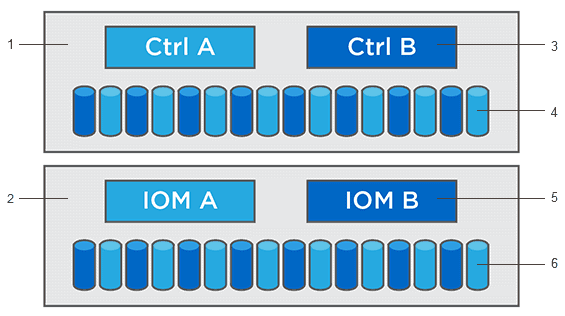Learn about upgrading SANtricity software
 Suggest changes
Suggest changes


Use the Upgrade Center to download the latest software and firmware and to upgrade your controllers and drives.
Controller upgrade overview
You can upgrade your storage array's software and firmware for all the latest features and bug fixes.
Components included in the OS controller upgrade
Several storage array components contain software or hardware that you might want to upgrade occasionally.
-
Management software — System Manager is the software that manages the storage array.
-
Controller firmware — Controller firmware manages the I/O between hosts and volumes.
-
Controller NVSRAM — Controller NVSRAM is a controller file that specifies the default settings for the controllers.
-
IOM firmware — The I/O module (IOM) firmware manages the connection between a controller and a drive shelf. It also monitors the status of the components.
-
Supervisor software — Supervisor software is the virtual machine on a controller in which the software runs.

1 Controller shelf; 2 Drive shelf; 3 Software, controller firmware, controller NVSRAM, supervisor software; 4 Drive firmware; 5 IOM firmware; 6 Drive firmware
You can view your current software and firmware versions in the Software and Firmware Inventory dialog box. Go to , and then click the link for Software and Firmware Inventory.
As part of the upgrade process, the host's multipath/failover driver and/or HBA driver might also need to be upgraded so the host can interact with the controllers correctly. To determine if this is the case, see the Netapp Interoperability Matrix Tool.
When to stop I/O
If your storage array contains two controllers and you have a multipath driver installed, the storage array can continue processing I/O while the upgrade occurs. During the upgrade, controller A fails over all of its volumes to controller B, upgrades, takes back its volumes and all of controller B's volumes, and then upgrades controller B.
Pre-upgrade health check
A pre-upgrade health check runs as part of the upgrade process. The pre-upgrade health check assesses all storage array components to make sure the upgrade can proceed. The following conditions might prevent the upgrade:
-
Failed assigned drives
-
Hot spares in use
-
Incomplete volume groups
-
Exclusive operations running
-
Missing volumes
-
Controller in Non-optimal status
-
Excess number of event log events
-
Configuration database validation failure
-
Drives with old versions of DACstore
You also can run the pre-upgrade health check separately without doing an upgrade.
Drive upgrade overview
Drive firmware controls the low-level operating characteristics of a drive. Periodically, the drive manufacturers release updates to drive firmware to add new features, improve performance, and fix defects.
Online and offline drive firmware upgrades
There are two types of drive firmware upgrade methods: online and offline.
Online
During an online upgrade, drives are upgraded sequentially, one at a time. The storage array continues processing I/O while the upgrade occurs. You do not have to stop I/O. If a drive can do an online upgrade, the online method is used automatically.
Drives that can do an online upgrade include the following:
-
Drives in an Optimal pool
-
Drives in an Optimal redundant volume group (RAID 1, RAID 5, and RAID 6)
-
Unassigned drives
-
Standby hot spare drives
Doing an online drive firmware upgrade can take several hours exposing the storage array to potential volume failures. Volume failure could occur in these cases:
-
In a RAID 1 or RAID 5 volume group, one drive fails while a different drive in the volume group is being upgraded.
-
In a RAID 6 pool or volume group, two drives fail while a different drive in the pool or volume group is being upgraded.
Offline (parallel)
During an offline upgrade, all drives of the same drive type are upgraded at the same time. This method requires stopping I/O activity to the volumes associated with the selected drives. Because multiple drives can be upgraded concurrently (in parallel), the overall downtime is significantly reduced. If a drive can do only an offline upgrade, the offline method is used automatically.
The following drives MUST use the offline method:
-
Drives in a non-redundant volume group (RAID 0)
-
Drives in a non-optimal pool or volume group
-
Drives in SSD cache
Compatibility
Each drive firmware file contains information about the drive type on which the firmware runs. You can download the specified firmware file only to a compatible drive. System Manager automatically checks compatibility during the upgrade process.


